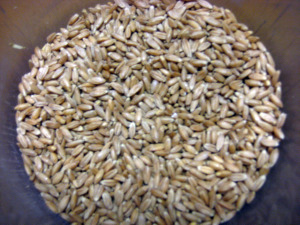The Importance Of Whole Foods (Or Why You Should Avoid Refined Foods)
 Whole Spelt Berries
Whole Spelt Berries
Whole grains, whole foods and the like are big buzzwords these days. You’ll hear these words advertised on TV, radio, in print and on many packaged foods. But what are whole foods and whole grains, why are they so important and why should you try to avoid refined/packaged foods?
In this post, I will give you a run-down on what whole foods are, why they are important and why you should avoid their lesser counterparts, refined foods and why they are not so good for you. I’ll also give some reasoning as to why you should consume more “whole foods” and some examples of whole foods and processed foods to help give you a better understanding so you can make better informed choices.
So firstly, what are Whole Foods?
Whole foods are food in their natural whole state. They are food that have not been refined or processed, or adulterated. This means that they have not been broken down physically and/or chemically into lesser parts then sold, made or eaten as just a part or fragment of the whole of the food. A common example of a whole food is a brown rice and and its lesser refined counterpart is white rice (which has been milled to remove the bran and the germ). Brown rice only has the husk removed (so the nutrients stay intact).
A Diagram of a Whole Grain
The kernel of a whole grain generally contains three parts:
-
The Bran: Contains fibre and a protein-rich outer layer.
-
The Endosperm: The inner starchy core.
-
The Germ: Contains vitamins and essential fatty acids and antioxidants.

Picture Source For Kernel Image
So which parts are removed during refinement of grains? Generally the germ and bran, so as you can imagine this leaves mostly the starchy endosperm and not much else.
Reasoning For Consuming Whole Foods /Whole Grains:
- Fibre– Refined foods, like white flour contain much less fibre. Why is this bad? Fibre helps to slow down the absorption of sugars in whole grains, fruits and vegetables. This helps to slow the release of the sugars of the whole grains and the release of insulin.
- Nutrients– Like fibre, there are many other nutrients in foods which are more complete. Simply put if you eat the refined version you will miss out on most of these nutrients.
- More Nutrients Per Calories– Now I am not one to count calories, however many people do. Eating more whole foods can help you achieve your daily quota for certain minerals, vitamins and macro nutrients as they are more nutrient dense and have less calories than refined foods which can often be heavily laden which white sugar and unhealthy fats (which means more calories and less nutrients).
- Absorption– When foods are in their whole state and contain many of the nutrients within the food this often helps for it to be better assimilated into the body. An example of this is the consumption of whole milk rather than skim. When you drink skim or low fat milks you may miss out on being able to absorb the fat soluble ingredients. Why is this? We need fat in our diet to absorb fat-soluble vitamins.
- Avoiding Unnecessary Additives- Often if you look at labels of ingredients on packaged foods and products you will see sometimes many unknown chemical ingredients and numbers. Often people can be allergic to these ingredients. Often those foods contain unhealthy amounts of refined salts, sugars, flours and fats- all good reasons to choose whole foods over refined and processed foods. With whole foods you can have the confidence that the food you have only contains that food (and no hidden ingredients).
- Complex Carbohydrates– Whole grains contain complex carbohydrates. Because of the milling of grains, refined grains miss out on the nutrients that are contained in its previous state and so digests differently in the body. They will act more like simple carbohydrates because of their missing nutrients.
Examples of Whole foods (And Foods Which Are Better To Consume):
- Whole Grains: Amaranth, Buckwheat, Brown Rice, Quinoa Grain, Whole Spelt Grains, Kamut.
- Wholegrain pasta such as buckwheat pasta.
- Wholegrain and sprouted flours.
- Fresh whole fruits and vegetables.
- Sea vegetables.
- Whole nuts and seeds.
- Rapadura sugar.
- Raw honey.
- Meats which just contain “meat” and nothing else.
- Himalayan sea salt /Celtic sea salt.
- (Sun Salt for those in Australia this is a really great environmentally choice for an unrefined salt).
- Whole fat organic milk (rather than fat free, skim etc.).
- Real butter (rather than margarine or processed butter “alternatives”).
- Unrefined cold-pressed oils.
- Wild or poll-caught fish, rather than farmed fish.
Examples of Processed Foods and Refined (which are best to avoid):
- White bread.
- White sugar.
- White flours.
- White flour products.
- White rice.
- Foods with labels that have indistinguishable ingredients.
- Sodas and soft drinks.
- Lollies and sweets.
- Potato Chips.
- Processed meats: hot dogs, lunch meats etc.
- Margarine.
- Refined oils.
- Refined & low fat dairy products.
- White salt with caking agents.
- Commercially farmed fish.
Of Course Sometimes You Can’t Always Eat Everything As A “Whole food”….
Every food has different properties and constituents. Sometimes it actually may not be beneficial and healthy to eat the whole of a food. For example, the green skins of the watermelon and the skins of mango are thought to be toxic so you wouldn’t really want to eat those. Other parts of certain foods are are inedible so you need to be mindful as to which parts are healthy to eat and which are not.
Something that which may not necessary be thought of as a whole food, but which are still pretty beneficial to our health are Juices. Of course not all juices are created equally. If you can it’s best to juice your own juices from fresh fruit and vegetables. Even though you miss out on some fibre, generally juices are quite healthy as a nutritious drink, especially juices from green vegetables (which are generally more nutrient dense).
Another food which many not be thought of as a whole food are fish and flax oils (and other unrefined cold-pressed oils). Even though we can still eat the whole of fish and flax seeds, their oils are both highly nutritious and can be good additions to ones diet.
A Word on Proper Preparation of Food
Of course just because you have something that is “whole” doesn’t mean it may necessarily be easily absorbed or digested well. In the case of grains, legumes and pulses they need to be soaked and/or fermented/cooked in order for your body to extract its nutrients and absorb them.
One Last Thought To Think About…
I thought I just might leave one more thought to think about:
Michael Pollan in his book, ‘In Defence of Food: An Eater’s Manifesto‘, talks about white flour and why it has a long shelf life. Want to know the shocking reason why white flour has such a long shelf? The reason is because pests do not want to eat flour which is depleted and devoid of nutrients! It makes you think if tiny organisms and pests do not want to eat this food, why should we? And how will this be good for the friendly microscopic bacteria within us and our tiny cells which depend on those bacteria and need replenishment from real foods? Something else Michael Pollan has said, was that if your grand-mother, or great-grand mother would not be able to identify or recognize it as food then don’t eat it!
So I hope I have made things a little clearer about what whole foods are, what they are and why it is better to avoid refined and processed foods.
*12th Feb 2010 this post was submitted to Food Renegade’s Fight Back Fridays.
Thanks for reading!


















{ 9 comments… read them below or add one }
I really enjoyed your article on whole foods. Recently I have been researching this topic and this has been really helpful. Your readers may also be interested in the Southwest Institute of Healing Arts blog. There is a post about Chef Rachel Matesz who is the Whole Foods Cooking class instructor at SWIHA, she has also published books and appeared on TV several times.
Hi Emily.
Glad you like it and it was helpful! Thanks for that link I’ll have a look! :)
I’ll be putting up more posts about whole foods/ whole grains soon!
Thanks for stopping by,
Michelle (Health Food Lover)
I have just discovered your site and wow what a great one! I really enjoyed this article about wholefoods. It’s hard to find really good products that are pre made with whole grains and really nutritious ingredients in them. My favourite though is Sprouted Grain bread from LifeStyle Bakery. I get it from Thomas Dux and I think this bread is one of the best products around for quality and nutrition (apart from fruit and veg straight off the plant).
Hi Cindy,
Thank-you :). Yeah I really like LifeStyle Bakery too. I’ve listed them on my Health & Food Resources Page (as as many other ‘healthy’ suppliers). I’m gonna update that page regulary so people have the best info of where they can get good food!
Have you tried Essene Bread? It has quite a different texture to other sprouted breads as its just sprouts minced and then dehydrated or slowly cooked for a long time. Its really quite nice, almost cake-like. I have a recipe for Sprouted Essene Bread on my site.
Thanks for stopping by!
Michelle (Health Food Lover)
Interesting that white flour is undesirable to pests and so desirable to so many of us! great, informative post.
Hi Chanelle, thanks for visiting!
Yeah it just makes sense doesn’t it. White flour is also meant to be bad for worm farms aswell and whole grain/wheat products are encouraged to feed to them, funnily enough!
Thanks for reading & commenting :)
Michelle (Health Food Lover).
just found your blog. great more people who are dedicated to eating natural whole foods.
please check my blog too.
Hi Health Food Lover,
I really enjoyed your post and it’s really one of the best I have ever read. It is one to add to my food bible. Here in the USA we tend to eat everything and I do mean EVERYTHING in moderation. I think most of us forgot the term avoidance. I worked at a local high school this past year. I was talking to one of the ladies in food service and asked her why in the world do they serve doughnuts. She said that the nutritionist that comes to the school considers it a grain. How about that! Refined white flour,sugar,sodium and saturated fat = junk food that shouldn’t be eaten. That’s why 67% of the USA is overweight.
I love bread ,so I try to find the ones with the most whole grains, which are very few and even those breads are even ruined in some way.Can you recommend a good healthy bread recipe?
Thank you
Hi Michelle,
A very interesting article.
I would be interested to know what you think of coconuts, ie, coconut fat, milk / water, and flour. I know that coconut is a saturated fat but is a medium chain fatty acid.
Regards
{ 6 trackbacks }